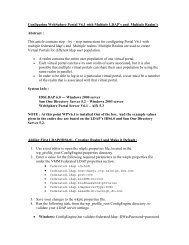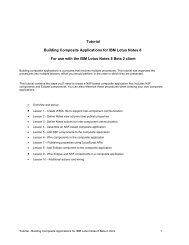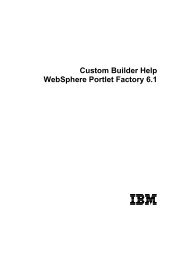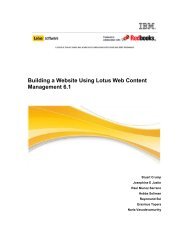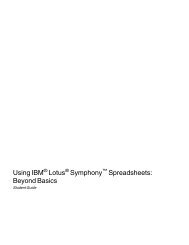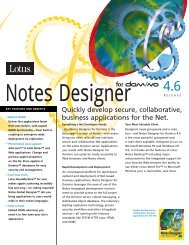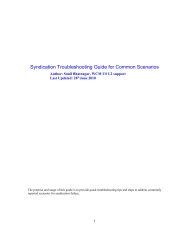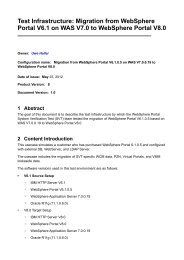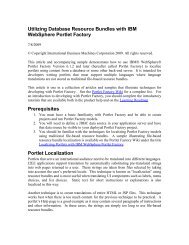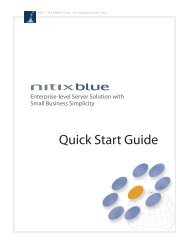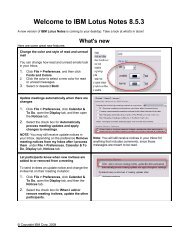IBM WebSphere Portlet Factory Overview - Lotus
IBM WebSphere Portlet Factory Overview - Lotus
IBM WebSphere Portlet Factory Overview - Lotus
You also want an ePaper? Increase the reach of your titles
YUMPU automatically turns print PDFs into web optimized ePapers that Google loves.
5. Run with system tracing to see exactly what actions get executed. Systemtracing can be used to see all the high-level model actions during execution. Systemtracing also gives you a quick look at the performance of all the actions, so you canoften quickly spot a performance issue. You can enable system tracing in the “Run”configuration dialog for <strong>WebSphere</strong> <strong>Portlet</strong> <strong>Factory</strong> Models, on the “Tracing” tab. Thesystem tracing output is written to the system output file (for Portal Server, this is theserver’s log/SystemOut.log file).6. Use Java-level debugging. To set up Java debugging (with single-step,breakpoints, etc.), you can use the remote debugging capabilities of Eclipse. Seeinformation in <strong>WebSphere</strong> <strong>Portlet</strong> <strong>Factory</strong> product help for how to set this up.DeploymentThis section covers at a high level a couple of important tips and best practices fordeployment. For a more complete document on this subject, refer to the <strong>WebSphere</strong><strong>Portlet</strong> <strong>Factory</strong> help system. A helpful document on project configuration and WARdeployment is located underneath Working with <strong>WebSphere</strong> <strong>Portlet</strong> <strong>Factory</strong><strong>Overview</strong>: Deployment Deployment Configurations in a nutshell. Another usefuldocument about deploying portlet wars is located underneath Tasks Working with<strong>WebSphere</strong> <strong>Portlet</strong> <strong>Factory</strong> <strong>Overview</strong>: Deployment Deployment for Production.Hint 1. Remember to add a <strong>Portlet</strong> Adapter builder to your model.The <strong>Portlet</strong> Adapter builder tells <strong>WebSphere</strong> <strong>Portlet</strong> <strong>Factory</strong> to add your model to theWAR file. If your model does not have a <strong>Portlet</strong> Adapter builder in it, it will not becontained in your WAR file.Hint 2. Change deployment properties by right-clicking your project and selectingProperties. In the Properties Window, expand <strong>WebSphere</strong> <strong>Portlet</strong> <strong>Factory</strong> andselect Project Deployment Configurations.After you have created your project, and can always go back and modify your projectproperties. For example, you might decide that auto-deploy of the portlet WAR file is tooslow, and you want to disable this feature. All of this is easily accomplished by modifyingyour project’s deployment configuration.Hint 3. Reduce the size of your WAR file by removing unnecessary files frombeing built into the WAR file.Suppose you have several samples, test models, images, and HTML files that you usedduring development, but are not required for your production portlets to work. In order toreduce the size of your WAR file, you can exclude these files from being deployed.There are two ways to do this:• Create a directory called **/nodeploy/**. Artifacts placed within thisdirectory are not included in a deployed WAR file. Note that you can create oneor more /nodeploy/ directories at any location within a project. You can thenplace within these directories all of the project artifacts that you do not wantincluded in the deployed WAR. When the WAR is built by the Ant scripts, thecontents of the /nodeploy/ directories will be excluded from the buildprocess.• Use the .excludeFromServer file. Artifacts listed in this file are not includedin a deployed WAR file. There are two versions of this file:<strong>WebSphere</strong> <strong>Portlet</strong> <strong>Factory</strong> V6.0.1 Getting Started Guide - 41 -



